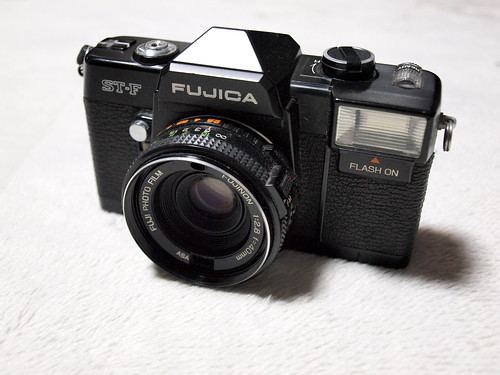Difference between revisions of "Fujica ST-F"
(Add details on exposure setting and how the shutter works.) |
m (minor tweak.) |
||
| Line 11: | Line 11: | ||
The Fujica ST-F was a circa-1975 attempt by [[Fuji]] to create a crossover between the features of an [[SLR]] and a simpler point & shoot (more than a decade before the concept of the "bridge camera" flowered with models like the [[Chinon Genesis]]). The 40mm f/2.8 lens cannot be removed, film advance is by simple thumbwheel, and a [[CdS]] cell reads the scene brightness from above the lens (not through it). The exposure is set by turning the aperture ring until the green LED is on. The behind-the-lens mirror shutter is "programmed" in that its speed is coupled to the aperture setting. A built-in flash is included. | The Fujica ST-F was a circa-1975 attempt by [[Fuji]] to create a crossover between the features of an [[SLR]] and a simpler point & shoot (more than a decade before the concept of the "bridge camera" flowered with models like the [[Chinon Genesis]]). The 40mm f/2.8 lens cannot be removed, film advance is by simple thumbwheel, and a [[CdS]] cell reads the scene brightness from above the lens (not through it). The exposure is set by turning the aperture ring until the green LED is on. The behind-the-lens mirror shutter is "programmed" in that its speed is coupled to the aperture setting. A built-in flash is included. | ||
| − | The mirror shutter is different from those found on the [[Exa (original)|Exa]] or the [[Pilot Super]]. Instead of having a second blade moving up to close the shutter, the mirror itself returns immediately to end the exposure. The shutter speed is set by limiting how far the mirror can | + | The mirror shutter is different from those found on the [[Exa (original)|Exa]] or the [[Pilot Super]]. Instead of having a second blade moving up to close the shutter, the mirror itself returns immediately to end the exposure. The shutter speed is set by limiting how far the mirror can flip up before it returns. This is done through a lever coupled to the aperture ring. The larger aperture size, the larger angle the mirror flips, and thus the longer exposure time. |
The [[Great Wall PF-1]] is a direct copy of this camera, made in molded plastic. | The [[Great Wall PF-1]] is a direct copy of this camera, made in molded plastic. | ||
Revision as of 23:29, 20 October 2011

|
| image by tkhs2525 (Image rights) |
The Fujica ST-F was a circa-1975 attempt by Fuji to create a crossover between the features of an SLR and a simpler point & shoot (more than a decade before the concept of the "bridge camera" flowered with models like the Chinon Genesis). The 40mm f/2.8 lens cannot be removed, film advance is by simple thumbwheel, and a CdS cell reads the scene brightness from above the lens (not through it). The exposure is set by turning the aperture ring until the green LED is on. The behind-the-lens mirror shutter is "programmed" in that its speed is coupled to the aperture setting. A built-in flash is included.
The mirror shutter is different from those found on the Exa or the Pilot Super. Instead of having a second blade moving up to close the shutter, the mirror itself returns immediately to end the exposure. The shutter speed is set by limiting how far the mirror can flip up before it returns. This is done through a lever coupled to the aperture ring. The larger aperture size, the larger angle the mirror flips, and thus the longer exposure time.
The Great Wall PF-1 is a direct copy of this camera, made in molded plastic.
Links
In Japanese:

|
| image by Renaldy Fernando Kusuma (Image rights) |